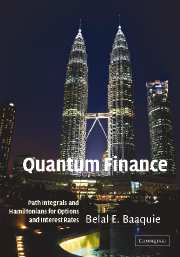Book contents
- Frontmatter
- Contents
- Foreword
- Preface
- Acknowledgments
- 1 Synopsis
- Part I Fundamental concepts of finance
- Part II Systems with finite number of degrees of freedom
- 4 Hamiltonians and stock options
- 5 Path integrals and stock options
- 6 Stochastic interest rates' Hamiltonians and path integrals
- Part III Quantum field theory of interest rates models
- A Mathematical background
- Brief glossary of financial terms
- Brief glossary of physics terms
- List of main symbols
- References
- Index
6 - Stochastic interest rates' Hamiltonians and path integrals
Published online by Cambridge University Press: 22 February 2010
- Frontmatter
- Contents
- Foreword
- Preface
- Acknowledgments
- 1 Synopsis
- Part I Fundamental concepts of finance
- Part II Systems with finite number of degrees of freedom
- 4 Hamiltonians and stock options
- 5 Path integrals and stock options
- 6 Stochastic interest rates' Hamiltonians and path integrals
- Part III Quantum field theory of interest rates models
- A Mathematical background
- Brief glossary of financial terms
- Brief glossary of physics terms
- List of main symbols
- References
- Index
Summary
All stochastic models of spot and forward interest rates are based on a finite number of degrees of freedom, and are precursors of the more general modelling of interest rates based on quantum field theory, which forms the subject of all the subsequent chapters.
The formalism of quantum field theory requires one to make a fairly large transition in the level of mathematical complexity. The path-integral and Hamiltonian analysis of stochastic interest rate models is undertaken to smoothen this transition, as well as for its intrinsic importance. The key ideas that will be later given a field theory generalization are introduced in stochastic models that have, at each instant, only a finite number of independent random variables.
Spot interest rate Hamiltonian and Lagrangian
The spot interest rate r(t) is the interest rate for an overnight loan at time t. Spot rate models are useful for modelling the short time behaviour of the interest rates' yield curve, as well as in the study of the stock market. Furthermore, since central bank policies intervene in determining the spot rate, jumps and discontinuities in the spot rate are particularly important, and need to be considered separately from the remaining yield curve.
We consider only the arbitrage-free, and not the empirical, martingale time evolution of the spot interest rate, as is required for pricing its derivatives. The interest spot rate models can hence be directly modelled using the Langevin equation.
- Type
- Chapter
- Information
- Quantum FinancePath Integrals and Hamiltonians for Options and Interest Rates, pp. 117 - 144Publisher: Cambridge University PressPrint publication year: 2004
- 4
- Cited by



